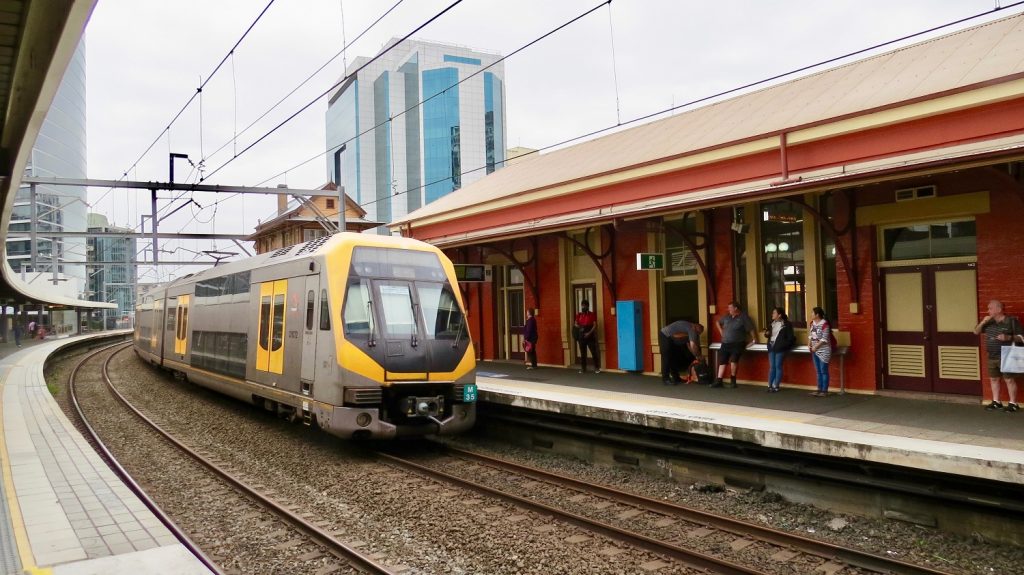DALLS SHERRINGHAM
FEW commuters sipping on their morning coffee and waiting for a train would realize they are standing on one of the most historic railway sites in Australia.
Parramatta railway station is a heritage-listed railway station located on the Main Western line and it was once the gateway to inland NSW when monster steam locomotives ruled the rails.
In the modern era, Parramatta’s 1859 station building has now become one of the most if not the most important NSW railway heritage station due to its age and status.
Parramatta station is one of Sydney’s oldest and the colonial first line connected Sydney and Parramatta near Granville and opened in 1855. It was extended to the current Parramatta station four years later.
Prior to the Main Western line being quadrupled from Granville to Westmead in 1985, the station consisted of four platforms, platforms three and four on the main line and one and two on a loop.
The station is the earliest surviving example of John Whitton’s work since the past demolition of Campbelltown Railway Station took place, removing that station as the oldest example of his work in NSW.
During the late 18th century and early 19th centuries, the ‘far western’ Sydney district surrounding Parramatta saw it become a specialized area, producing and providing agriculture foods for the colony.
A military settlement was established close to the Parramatta River and during the early 1800s the town evolved from a convict settlement into a free town as Crown grants were provided.
Very importantly Parramatta featured early on in the NSW railway plans as it was on the very first few first section of the NSW railway network to be completed and put into service.
With the opening of the new railway line at Parramatta, the layout and focus of the town shifted and this saw the railway system begin to become used for the various industries around the town.
When the building boom evolved
They were encouraged to move from near the Parramatta River to the area around Parramatta Station where a faster and cheaper method of transporting goods and people was available, whereas before all the goods were shipped down the river system.
Residential settlement in the area was also encouraged by the newly extended railway line and the subdivision of central land grants. By the 1880s the local population of Parramatta area was beginning to rise and a building boom evolved to cater for this need.
In response to the population growth and increase for the transportation of people and goods, the line between Granville and Parramatta was duplicated in 1879 to provide room for more paths for trains and services.
As a result this also saw Parramatta station upgraded in 1882. With a duplication on the Blacktown section completed in 1886 this also saw the Parramatta Signal Box opened to handle more traffic.
From the late 1880s and into the 1890s , the commercial centre of Parramatta moved southward to the area immediately surrounding the Railway Station.
In a move which may surprise people when compared with modern era Sydney, in the 1880-90s, the residential properties were converted to commercial premises surrounding the station. This process had virtually reached completion along Argyle Street by the early 1920s.
With expanding services, by the late 1920s electric trains were being introduced across Sydney to replace steam hauled services for passengers and this saw the line duplicated to Parramatta.
During the 1940s the next major period of development of Parramatta railway station took place which saw the quadruplication of the railway line and construction of Platform Four.
This new platform built at a time of war, served the new Defense site at St Marys as well as Army personnel from nearby Lancer Barracks.
Since the mid-1940s a number of minor modifications have occurred to the overall station layout. The next major improvement work including a wider pedestrian subway, ramps and centralized ticketing facilities coincided with the construction of the Western Concourse in 1985. An eastern side concourse located underground was opened in 1996. The western concourse was renewed in 2006.
When seen in its entire context, the Parramatta Railway Station has very high aesthetic significance due to the importance placed on the railway platforms built over a range of nearly 80 years.
They cover a variety of historical periods and indicate a wide range of architectural styles from the Victorian Free Classical Style of the original 1859 station building and platform one, the late Victorian style 1880s station building and signal box, through to the Functionalist style of the 1942 building as seen on platform four.
The existing platforms cover from 1859 to 1942 in construction and show the different methods used in modifying the precinct for accommodating the growing use of the station.
STATION FEATURES
Today, it is served by Sydney Trains T1 Western Line, T2 Inner West and Leppington and T5 Cumberland Line services.
The inland tradition continues with the NSW TrainLink Blue Mountains Line, Central West XPT and Outback Xplorer services.
In 1985, the station was refurbished with a new underground subway bus interchange built at the station’s north-east side.
There always seems to be some improvement at the site.
In late 2003, work began on a new transport interchange which linked the station to the neighboring Westfield Parramatta shopping centre.
The much needed works included upgrading the station, providing more access to commuters, and constructing a new bus interchange. It opened in 2006.
In October 2016, the Parramatta Turnback Project was completed, adding crossovers to allow trains to terminate in either direction.
The new Parramatta metro station will be located around a block to the north of the current station.
Sources: Sydney railway stations web site, Wikipedia





